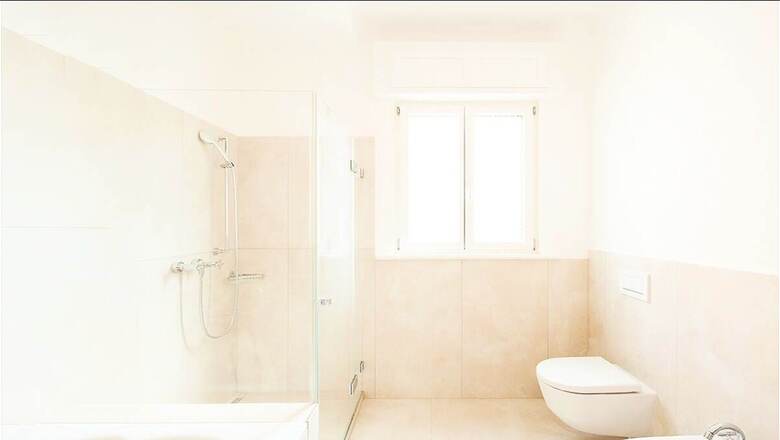
views
Would you ever use a stinky toilet? For most of us, we’d have to be pretty desperate to use one. Stinky toilets are, however, a pretty regular feature of the monsoon road trip. This is because the monsoon season brings many challenges for toilet maintenance – especially in rural areas where toilets and sanitation facilities are often inadequate or poorly designed.
One of the most common problems is the lack of proper ventilation, which can lead to a number of issues such as moisture build-up, unpleasant odours, and health risks.
Why is proper ventilation important for monsoon-proof toilets?
Proper ventilation is important for any toilet, but especially for those that are exposed to high humidity and rainfall during the monsoon season. Without adequate ventilation, the following problems can occur:
Moisture build-up:
Monsoons are characterised by high humidity levels and increased moisture in the air. When this moisture finds its way into closed spaces like toilets, it can lead to an array of problems like mould, mildew, and dampness. Excessive moisture can even cause damage to the toilet structure, such as rusting of metal parts, rotting of wood components, and cracking of cement or tiles. Moisture can also create a breeding ground for mould, fungi, and bacteria, which can affect the quality of the toilet and pose health hazards for the users.These conditions not only compromise the structural integrity of the toilet but also create an unhealthy environment that can contribute to respiratory issues and allergies.
Unpleasant odours:
Another common issue faced during monsoons is the persistence of unpleasant odours in closed spaces. Inadequate ventilation makes this problem worse as stagnant air fails to carry away foul smells, allowing them to linger in the toilet. The combination of moisture and lack of proper airflow creates a breeding ground for bacteria and fungi, further intensifying the odorous situation. Poor ventilation can trap foul-smelling gases inside the toilet, such as ammonia, hydrogen sulphide, and methane. These gases are produced by the decomposition of human waste and other organic matter in the toilet. They can cause discomfort and nausea for the users, and also attract flies and other pests that can spread diseases.
Health risks:
Lack of ventilation can reduce the oxygen level and increase the carbon dioxide level inside the toilet, which can affect the breathing and well-being of the users. Moreover, poor ventilation can increase the exposure to harmful pathogens and chemicals that may be present in the toilet environment, such as E. coli, Salmonella, nitrate, and arsenic. These can cause infections, diarrhoea, dehydration, and even poisoning.
How can proper ventilation be achieved for monsoon-proof toilets?
Proper ventilation can be achieved for monsoon-proof toilets by following some simple guidelines and using some low-cost materials. Here are some tips to improve the ventilation of your toilet:
Install a vent pipe:
A vent pipe is a vertical pipe that extends from the pit or tank of your toilet to above the roof level. It allows the gases produced by the waste to escape through the top, rather than accumulating inside the toilet. A vent pipe also creates a suction effect that draws fresh air into the toilet through the door or window openings. This helps to reduce odours and improve oxygen levels inside the toilet. A vent pipe can be made from PVC, metal, or bamboo, depending on the availability and affordability of materials. The diameter of the vent pipe should be at least 10 cm (4 inches), and it should be fitted with a mesh or screen at the top to prevent birds or insects from entering.
Add an exhaust fan:
A fan can enhance the ventilation of your toilet by increasing the airflow and removing the gases more quickly. Exhaust fans are highly effective in removing stale air and excess moisture. Place them strategically to achieve maximum air circulation and ensure they are regularly cleaned and maintained.
Create cross-ventilation:
Cross-ventilation is the movement of air across a space through two or more openings that are opposite or perpendicular to each other. Cross-ventilation can help to cool down your toilet and remove odours and moisture more effectively. To create cross-ventilation, you should have at least two openings in your toilet walls or roof that are facing different directions. These openings can be doors, windows, louvres, or vents. They should be large enough to allow sufficient airflow, but not too large to compromise privacy or security. You should also keep these openings clear of obstructions such as curtains, furniture, or plants. Natural ventilation through windows or skylights can supplement exhaust fans and allow fresh air to enter the toilet. Properly position these openings to encourage cross-ventilation.
Maintain cleanliness:
Regular cleaning and disinfection of toilets are essential to prevent the growth of mould and mildew. Keep surfaces dry and free from moisture to reduce the chances of microbial growth.
The Education and Awareness Gap
Particularly in parts of rural India, where toilets ‘inside the home’ are a new phenomenon, keeping toilets clean requires a learning curve. This isn’t a small problem, the Sub-Group of Chief Ministers on Swachh Bharat Mission also found that constructing toilets is just one half of the equation. We also need to bring about behavioural change when it comes to using toilets, and maintaining them. The most effective way to do this is through education.
Fortunately, in India, leading brands like Harpic have implemented effective communication strategies to promote good toilet hygiene and overall sanitation. Harpic has taken the initiative to create innovative and thought-provoking campaigns and outreach programs in the field of sanitation and hygiene.
It has also joined hands with News18 in the Mission Swachhta aur Paani initiative, which brings together all the right stakeholders in one platform, creating the right conditions for important conversations and actions to take place. Mission Swachhta aur Paani is a movement that advocates for inclusive sanitation, ensuring access to clean toilets for everyone. It promotes equality regardless of gender, abilities, castes, or classes, emphasising that clean toilets are a shared responsibility. Harpic and News18 are working hard to turn this vision into a lived reality.
Mission Swachhta aur Paani also serves as a great repository of all the information you need about improving toilets and sanitation – from the micro to the macro level. What’s needed now is your participation.
Join us here to learn about how you can help move the needle towards a Swachh and Swasth Bharat.




















Comments
0 comment